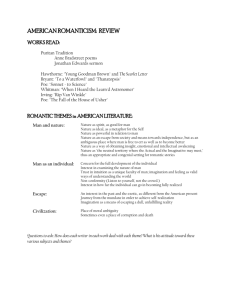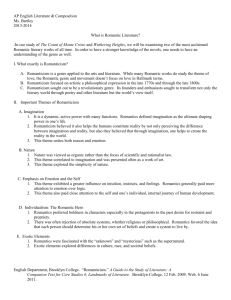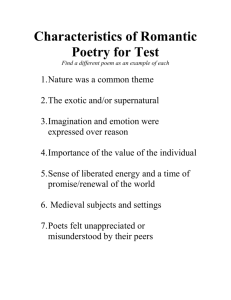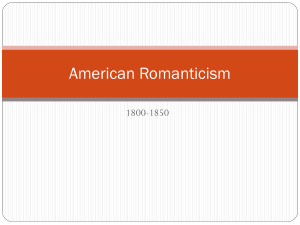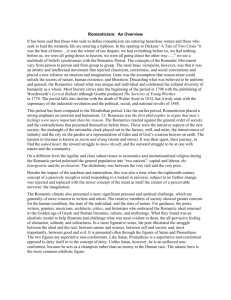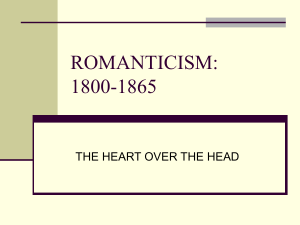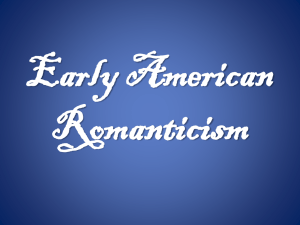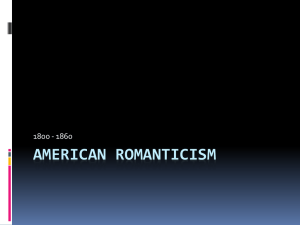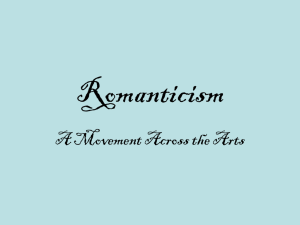Romanticism
advertisement
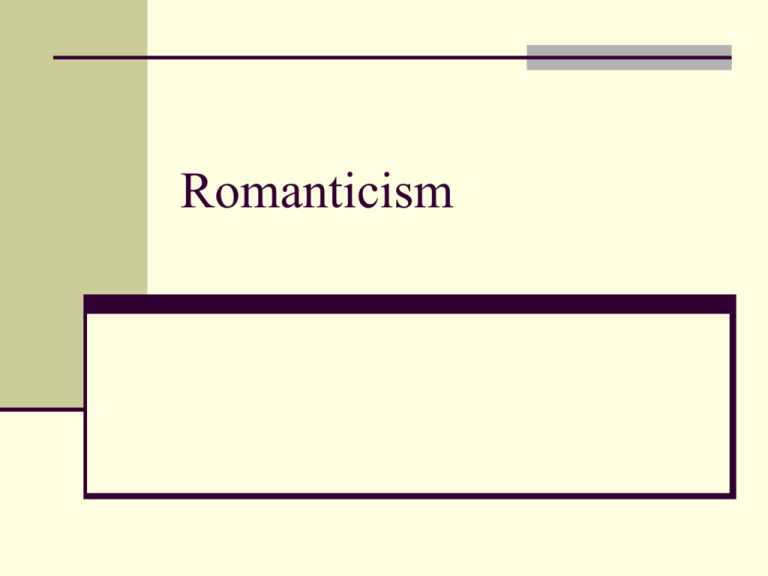
Romanticism Romanticism Romantic ideas arose both as criticisms of 18th century Enlightenment thought. Opposed and in conflict with the Enlightenment Narrowing of outlook, from the universal to the particular – from humankind, to man, nation ethnic group. Emphasis on individual and national uniqueness. Traits which set one man apart from another, one nation apart from another. Romanticism The Romantics attacked the Enlightenment because it rejected emotions and creativity. Attacked nature of urban industrial society. Industrial society brought new problems: soulless individualism, economic egoism, utilitarianism, materialism. Romanticism Enlightenment had turned man into a soulless, thinking machine -- a robot. Rejection of traditional authority. Enlightenment too objective -- saw human nature as uniform. Rejected the Enlightenment ideal of balance and rationalism. Revolution as a romantic idea. Still valid today. Revolutionaries are celebrated as Romantic characters. Jane Sandanski. Che Guevara t-shirts. Sacredness of the individual The modern fascination with self-definition and self-invention, the notion that adolescence is naturally a time of rebellion in which one "finds oneself," the idea that the best path to faith is through individual choice, the idea that government exists to serve the individuals who have created it: all of these are products of the romantic celebration of the individual at the expense of society and tradition. Sacredness of the individual Whereas the Enlightenment saw man as creatures endowed with Reason, the Romantics saw diversity and uniqueness. Faith in the absolute uniqueness of every human being. Rousseau: “I know the feelings of my heart, and I know men. I am not made like any of those I have seen. I venture to believe that I am not made like any of those who are in existence. If I am not better, at least I am different.” Sacredness of the individual Human nature is not universal. The idea of the self took on greater importance for philosophers, poets, political thinkers, novelists. Both the American and French Revolution developed out of strong convictions about the innate rights of individual human beings. Authority located in the self rather than in society. Sacredness of the individual Enlightenment stifled imagination, sensitivity, feelings, spontaneity and freedom. Imagination and feeling Emphasis on imagination and feeling. Reason vs feelings as the guide to certainty. Which one should be the guide, according to the Romantics? Why? Reason vs Feeling. Feeling as a guide to knowledge of the ultimate real. Women, children and “primitive” people had higher capacity to feel and express emotions. Imagination and feeling Romantics celebrated romantic love as the most exalted of human sentiments, and the necessary foundation of a successful marriage. The imagination is unleashed to explore extreme states of being and experiences. Feeling – purest form love. Prized the tender sentiments of affection, sorrow, and romantic longing. Evocation of strong, irrational emotions. Imagination and feeling The heart, not reason, was a source of knowledge. Trust your instincts. Limitations of scientific knowledge. Trust your experience of sensations. The imagination elevated to a position as the supreme faculty of the mind. This contrasted with the traditional arguments for the supremacy of reason. Imagination and feeling Greater emphasis on the importance of intuition, instincts, and feelings. Romantics called for greater attention to the emotions as a necessary supplement to purely logical reason. Religion Essential goodness of human nature. Compare to the religious view. Religious and social repressiveness was the enemy. Emphasis on inner (psychic) experiences. Literature and art Neoclassicism had prescribed for art the idea that the general or universal characteristics of human behavior were more suitable subject matter than the peculiarly individual manifestations of human activity. Romantic readers sought out the hysterical, mystical, passionate adventures of terrified heroes and heroines. Literature and art Evocation of strong, irrational emotions. Celebration of agonies of frustrated love. Wallowing in the longings and disappointments of frustrated protagonists. Symbolism and myth given great prominence in the Romantic conception of art. Wordsworth's definition of all good poetry as "the spontaneous overflow of powerful feelings“. Literature and art Prominence for first-person lyric poetry. Importance of the exotic. Generally anywhere south of the country where one was resided was considered more relaxed, more colorful, more sensual. Many male travelers viewed the women of almost any foreign as more sexually desirable and available than the women at home, and so they are depicted in fiction, drama, art, and opera. Nature Nature is a living, vitalizing force and offers a refuge from the constraints of civilization. The heart in communion with Nature.
